We all expected some surprising names among the non-tender list this offseason considering the circumstances surrounding the 2020 season. Kyle Schwarber’s name was mentioned in the conversations leading up to the deadline on December 2nd, but it was probably still viewed as a remote possibility and many still expected Schwarber to be tendered a contract for the 2021 season. But, as we learned, that did not happen.
Under normal circumstances, a player like Schwarber probably would have been tendered a contract, but it seems that Schwarber was a victim of the oddness that was the 2020 season. The shortened season makes it difficult to evaluate players that were either playing better than expectations or, in the case of Schwarber, worse than expected. After all, there was a lot of hype surrounding Schwarber coming into the year after he had his finest season to date in 2019. He posted a .250/.339/.551 triple slash with 38 home runs, all while playing nearly every day with 610 plate appearances.
A year later though, and the hype and enthusiasm appear to have died down considering his paltry .188/.308/.393 triple slash last season, which resulted in him being sent to free agency earlier than expected. There is also the argument that financial reasons may have played more of a factor in this decision than anything, but his performance still did not do him any favors.
While it may have been expected, it is still surprising to see Schwarber among the non-tendered players, because the things that made him such an intriguing option were still on display for the most part in 2020. He was still viewed quite favorably by Statcast for instance:
| Season | Barrel % | AVG EV | Max EV | Hard-Hit % |
|---|---|---|---|---|
| 2019 | 14.5 | 93.5 | 117.6 | 51.2 |
| 2020 | 11.2 | 92.8 | 114.9 | 47.2 |
Based on this table Schwarber was, more specifically, still viewed favorably in terms of hitting the ball hard. Sure, there are some regressions here, but this is still an overall healthy profile that saw Schwarber end up in the 95th percentile in average exit velocity, 86th percentile in hard-hit rate, plus 16th overall in maximum exit velocity. These are all good things, obviously, and they maybe don’t quite match up with Schwarber’s triple slash. Expected stats do view him more positively than the triple slash, but still not in the most flattering lights.
Even more curiously was that through the first month or so of the season, Schwarber actually looked more like the Schwarber we would expect. While a step back from his full 2019, he still did have a .500 slugging percentage and a .272 isolated power figure through the end of August. He was doing just fine, and then all of a sudden, he quite frankly, wasn’t. September was a real drag for Schwarber that just tanked his 2020 performance, thanks to a .130/.272/.234 triple slash and a minuscule 47 wRC+, eighth-worst among qualified hitters in the same span. One could even say that this one bad month from Schwarber cost him his spot on the Cubs.
While that is probably a little too extreme, that doesn’t mean his performance wasn’t warranted. There were some aspects of Schwarber’s season that look concerning. Let’s start with a look at Schwarber’s plate discipline:
| Season | Swing % | Z-Contact % | Whiff % | Chase % | K % |
|---|---|---|---|---|---|
| 2019 | 43.0 | 78.1 | 28.1 | 23.6 | 25.6 |
| 2020 | 42.7 | 78.1 | 28.2 | 27.6 | 29.5 |
From this, we see that while a lot of things do look similar year to year, Schwarber’s strikeout rate still jumped about four percentage points to 29.5%, which is also his highest rate since 2017. This jump doesn’t look to be due to whiffs, which while still considerably worse than league-average, is practically identical to his 2019 rate. Whiffs are a part of Schwarber’s game, so this is not likely to swing in a positive direction any time soon.
What is more concerning here is Schwarber’s elevated rate of chases. In the plate discipline department, Schwarber is more known for his good batting eye, and while that was still the case in 2020 as Schwarber did manage a 13.4% walk rate, he did chase more. At 27.6%, it is the highest chase rate for Schwarber since 2017 and is much closer to league-average than in previous years, which when combined with an elevated whiff rate compared to the rest of the league, it makes sense that he struck out more last season.
More strikeouts were definitely an issue for Schwarber, but the biggest kicker for him last season was that he all of a sudden turned into a groundball hitter. Groundballs were never really an issue for him in the past, but in 2020 he ran a 51% groundball rate which was miles up from his 38.8% clip in 2019 and by far the highest rate of his career. Taking a look at the hitters with the highest jump in groundball rate from 2019 to 2020, we see that Schwarber is among the leaders:
| Player | GB % 2020 | GB % 2019 | Difference |
|---|---|---|---|
| Austin Riley | 42.1 | 25.6 | 16.5 |
| Corey Dickerson | 52.2 | 36.7 | 15.5 |
| Cavan Biggio | 39.6 | 25.8 | 13.8 |
| Colin Moran | 57.5 | 43.9 | 13.6 |
| Kyle Schwarber | 51.2 | 38.8 | 12.4 |
| Josh Bell | 56.4 | 44.0 | 12.4 |
| Carlos Correa | 49.7 | 38.9 | 10.8 |
| David Fletcher | 55.1 | 44.4 | 10.7 |
| Adam Eaton | 52.7 | 42.2 | 10.5 |
| Juan Soto | 53.2 | 42.8 | 10.4 |
More groundballs are definitely concerning on their own (unless the hitter is Juan Soto, who is such a monster at the plate that it doesn’t really affect him), but more groundballs from a hitter like Schwarber may be even more concerning, considering the type of hitter he is. As a reminder, Schwarber is a left-handed, primary pull-hitter (especially his groundballs), and not the fastest player in the game. More grounders would make him a prime candidate for infield shifts, and that is exactly what happened last season. His shift rate jumped from 69.3% in 2019 to 81.6% in 2020, a top-20 rate among hitters with at least 150 plate appearances. Add in the extra grounders that he hit, and that is a good explanation for his .293 wOBA when facing a shift, among the lowest of any hitter with the same 150 plate appearances criteria.
So it looks like the biggest explanation for Schwarber’s 2020 struggles can be mostly attributed to a higher rate of groundballs and more shifts faced, but the real question is why might this have happened? Schwarber still hit the ball well, and while more of them ended up on the ground, is that enough of a reason for his performance to suffer as much as it did last season? It looks like some further digging is required.
The first area worth exploring is the type of pitches he was seeing. Upon first glance, it doesn’t look like much has changed in this department. Schwarber saw a few more breaking balls and actually saw more fastballs on a rate basis at 56.6% compared to 55.3% in 2019. That should’ve been good news for Schwarber, as fastballs are definitely his favorite type of pitch to hit. That has mostly been the case throughout his career, and especially so in 2019, with a .597 slugging percentage on them. Schwarber did regress when hitting fastballs last season, dropping to a .491 slugging percentage, but that is still strong and by expected slugging, he looked slightly better at .514. However, something noteworthy did happen during September, which again, was quite dreadful for Schwarber at the plate. Let’s let a simple graph do the talking here:
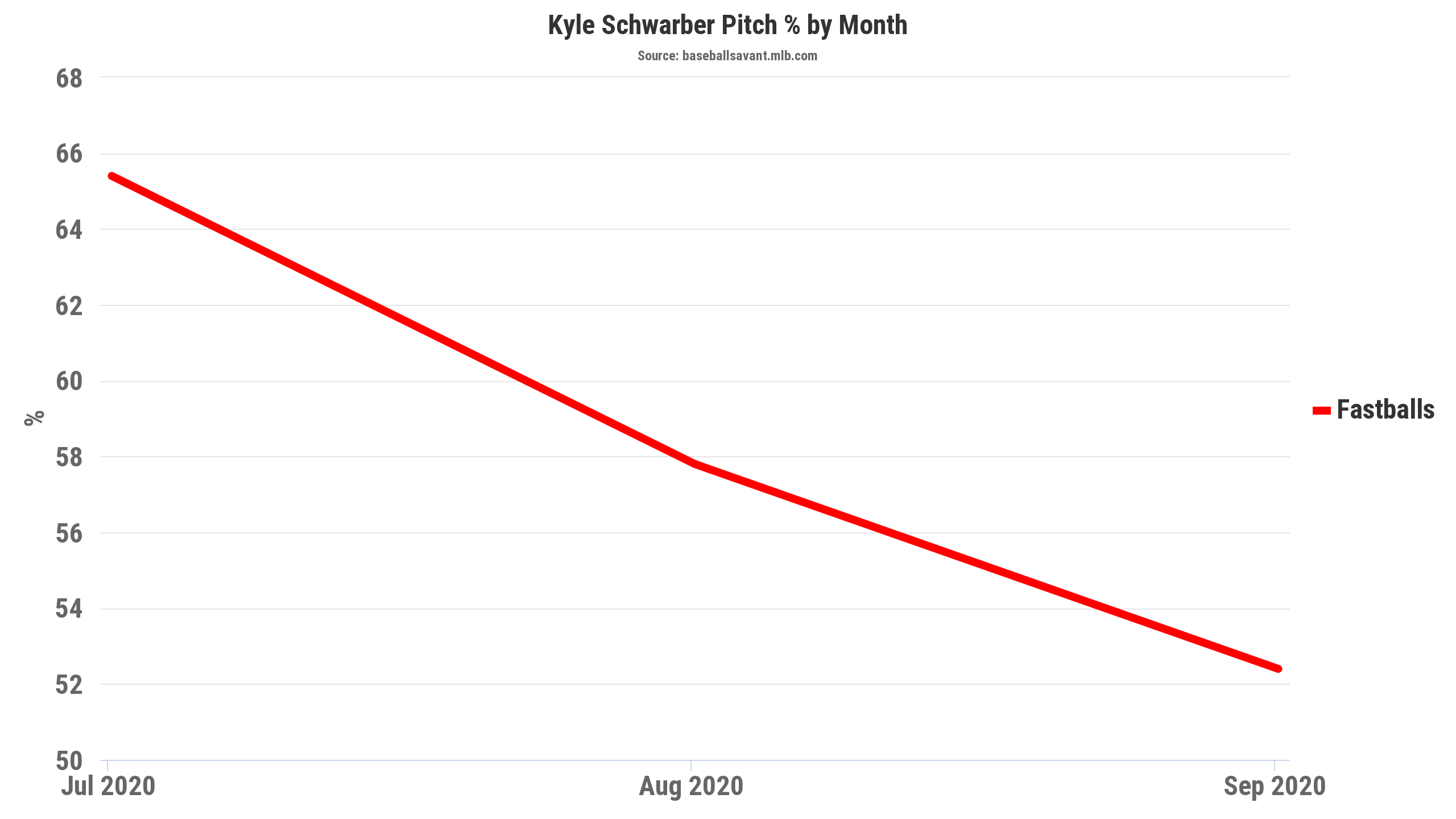
Ignore the month of July, as it was just a handful of games, but the drop in fastballs seen from August to September looks to be significant. He saw fastballs at just a 52.4% clip in September, down substantially from 57.8% in August, and among the lowest rates in the entire month, as well as the lowest rate in a single month for him in his entire career outside of April 2019. Pitchers appeared to have adjusted how they pitched to Schwarber. It makes sense from their perspective considering how well Schwarber has historically hit fastballs. Throwing fewer of them allows fewer opportunities for Schwarber to crush one, so it seems like a pretty good idea.
That alone is pretty notable, but it seems that pitchers also made another adjustment on top of this. Not only did he see fewer fastballs, but the fastballs that he did see were coming in a different location of the zone than usual. Consider the following three heatmaps. First, a look at Schwarber’s fastball heatmap from 2019:
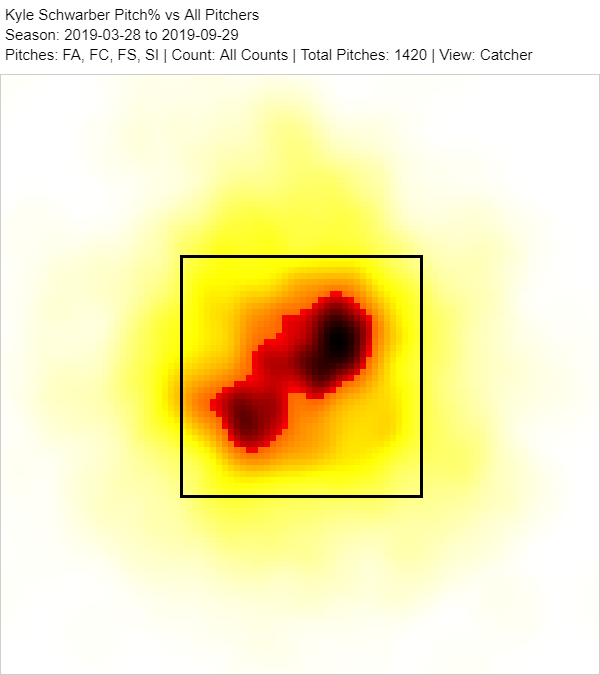
Next, a look at his fastball heatmap from July and August of 2020:
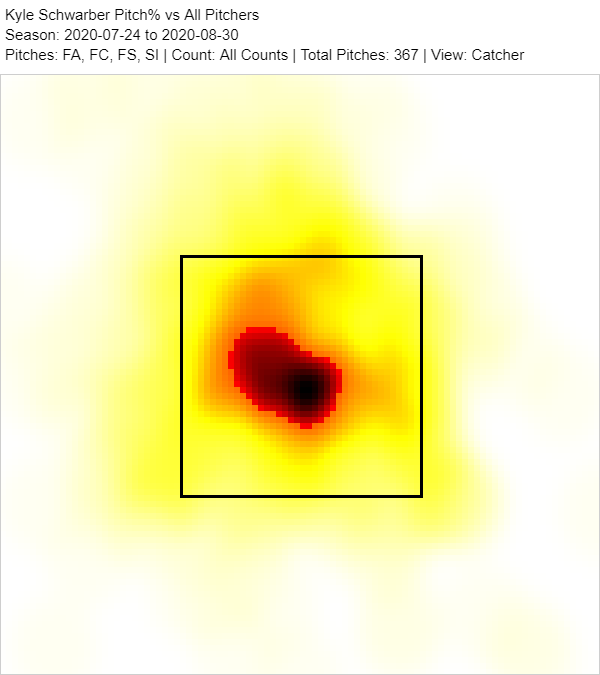
While not identical, there are some similar trends in that Schwarber saw a good amount of fastballs in the more center-ish areas of the plate. Keep that in mind as we shift to the third heatmap, which is a look at his fastball heatmap from September 2020:
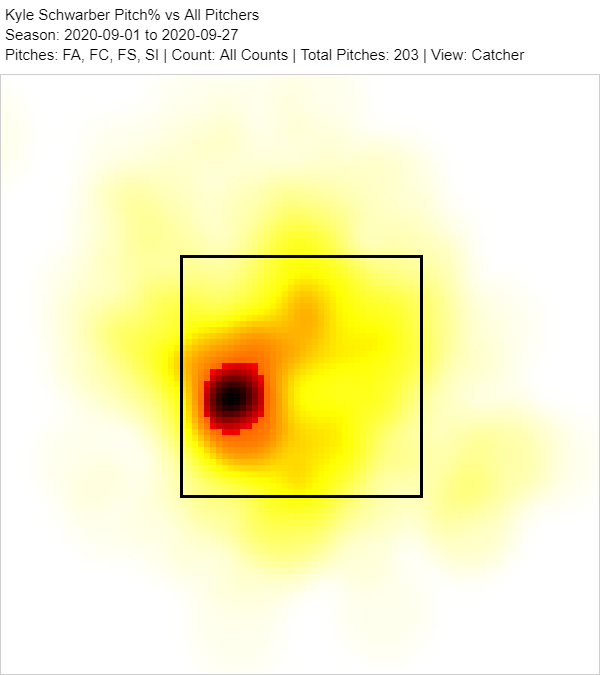
Holy smokes, that is quite the contrast, especially so from July-August of last season. While this is still just a small sample of pitches in an admittedly arbitrary cut-off point, it does look to have been a conscious decision by pitchers to pitch Schwarber a bit differently and throw him more fastballs on the outside portion of the plate. Just like throwing Schwarber fewer fastballs makes sense considering the strong historical results, throwing more fastballs on the outer half of the plate looks to be a good idea considering his fastball slugging heatmap from 2019, the best fastball-hitting season of his career:
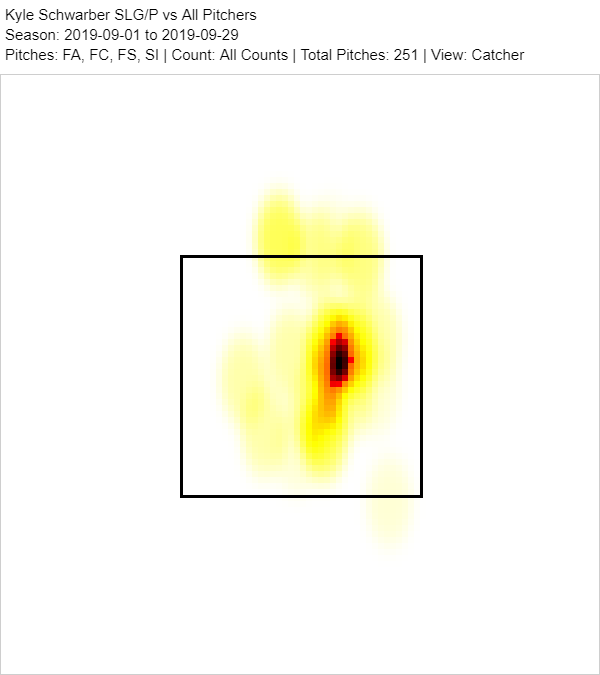
Schwarber never seemed to adjust to this change, as his spray chart on fastballs in September shows him continuing to pull the ball frequently:
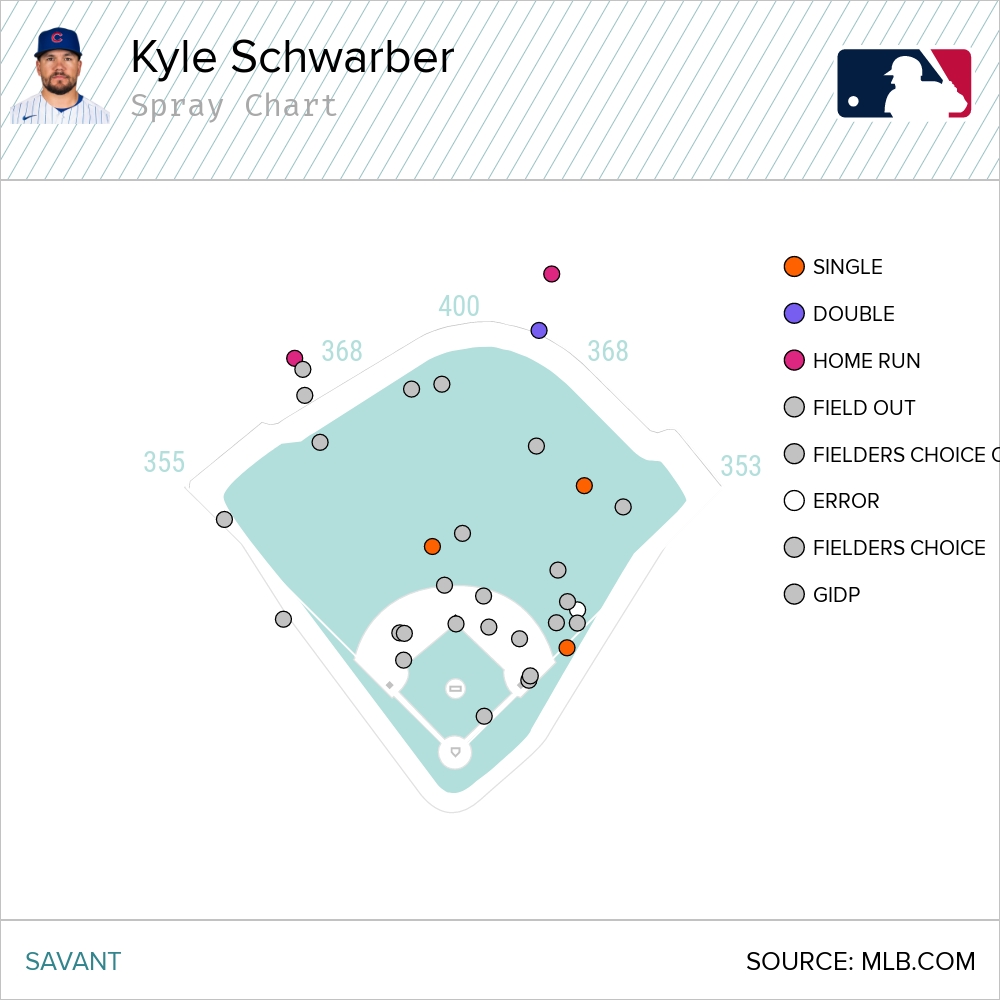
As well as grounders hit weakly or right into the shift, as shown here:
While two clips aren’t substantial examples of proof, it does appear that this adjustment made by pitchers at least partially explains how Schwarber ended up with the worst results on fastballs in a single month of his career. Combine that with declining numbers on the other pitch types which also helps explain what looks to be a completely deserved .356 expected slugging in September, and his overall down season.
So, ultimately, what do we do about this? Do we write this off and attribute it to 2020 weirdness? Do we buy back in or do we move on completely? It’s a tough decision, and it would be great if we had another few hundred plate appearances in which to evaluate, but we don’t have that luxury.
The arguments can be made in either direction. The optimist view is that—even through the down times last season—Schwarber continued to display excellence at hitting the ball hard, and it should be theoretically easier to learn how to hit outside fastballs than it would be to change his whole batted-ball profile. That does sound good in theory, but the other side would argue that Schwarber’s performance showed quite a few concerning and worrisome trends. Pitchers seemed to adjust how they were pitching to Schwarber, and after seeing how positive the results were for them, it would probably be a good idea for them to keep doing it until Schwarber can show that he can work around it.
The ball is in Schwarber’s court to see how he will respond. Before we can see that though, he first needs to land with another team. It shouldn’t be too difficult, but where he ends up will likely play some role in how his 2021 season goes. The designated hitter situation is making things a lot more complicated than they have to be, but Schwarber may end up in a platoon or even reserve role next season, which would cause a lot of his mainstream fantasy appeal to plummet.
Overall, Schwarber still does a lot of things right, but some things look to be trending in the wrong direction. While a bounce back is definitely possible, his struggles in 2020 should not just be chalked up to small-sample size randomness and it should not be written off completely, due to the concerning indicators mentioned here. He can reverse these trends, and doing so may be the difference between him looking like the Schwarber we know and expect, or just another player.
Photo by Jerome Lynch/Icon Sportswire | Adapted by Jacob Roy (@jmrgraphics3 on IG)


Thank you for explaining the seemingly inexplicable black hole that is Kyle Schwarber